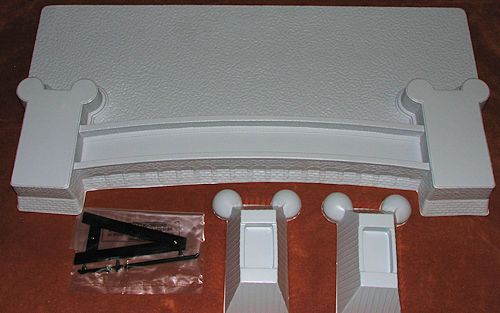
Airfix 1/72 'The Dambusters'
| KIT #: | A50061 |
| PRICE: | $54.00 SRP |
| DECALS: | One option |
| REVIEWER: | Scott Van Aken |
| NOTES: | Includes vacuform base, glue, brush and paints |

| HISTORY |
The two direct mine hits on the Möhnesee dam resulted in a breach around 250 feet (76 metres) wide and 292 feet (89 metres) deep. The destroyed dam poured around 330 million tons of water, equivalent to a cube measuring 687 metres, into the western Ruhr region. A torrent of water around 32.5 feet (10 metres) high and travelling at around 15 mph (24 km/h) swept through the valleys of the Möhne and Ruhr rivers. A few mines were flooded; 11 small factories and 92 houses were destroyed and 114 factories and 971 houses were damaged. The floods washed away about 25 roads, railways and bridges as the flood waters spread for around 50 miles (80 km) from the source. Estimates show that before 15 May 1943 water production on the Ruhr was 1 million tonnes, this dropped to a quarter of that level after the raid.
The Eder drains towards the east into the Fulda which runs into the Weser to the North Sea. The main purpose of the Edersee was then, as it is now, to act as a reservoir to keep the Weser and the Mittellandkanal navigable during the summer months. The wave from the breach was not strong enough to result in significant damage by the time it hit Kassel (approx. 35 km downstream).
The greatest impact on the Ruhr armaments production was the loss of hydroelectric power. Two powerplants (producing 5,100 kilowatts) associated with the dam were destroyed and seven others were damaged. This resulted in a loss of electrical power in the factories and many households in the region for two weeks. In May 1943 coal production dropped by 400,000 tons which German sources accredit to the effects of the raid.
According to the recent sources, at least 1,650 people were killed: around 70 in the Eder Valley, and at least 1,579 bodies were found along the Möhne and Ruhr rivers, with hundreds missing. 1,026 of the bodies found downriver of the Möhne Dam were foreign prisoners of war and forced-labourers in different camps, mainly from the Soviet Union. Worst hit was the city of Neheim (now part of Neheim-Hüsten) at the confluence of the Möhne and Ruhr rivers, where over 800 people perished, among them at least 493 female forced-labourers from the Soviet Union. (Some non-German sources erroneously cite an earlier total of 749 for all foreigners in all camps in the Möhne and Ruhr valleys as the casualty count at a camp just below the Eder Dam.)
After the operation Barnes Wallis wrote, "I feel a blow has been struck at Germany from which she cannot recover for several years." However, on closer inspection, Operation Chastise did not have the military effect that was at the time believed. By 27 June, full water output was restored, thanks to an emergency pumping scheme inaugurated only the previous year, and the electricity grid was again producing power at full capacity. The raid proved to be costly in lives (more than half the lives lost belonging to Allied POWs and forced-labourers), but in fact no more than a minor inconvenience to the Ruhr's industrial output. The value of the bombing can perhaps best be seen as a very real boost to British morale.
In his book Inside the Third Reich, Albert Speer acknowledged the attempt: "That night, employing just a few bombers, the British came close to a success which would have been greater than anything they had achieved hitherto with a commitment of thousands of bombers." However, he also expressed puzzlement at the raids: the disruption of temporarily having to shift 7,000 construction workers to the Möhne and Eder repairs was offset by the failure of the Allies to follow up with additional (conventional) raids during the dams' reconstruction, and that represented a major lost opportunity. Barnes Wallis was also of this view; he revealed his deep frustration that Bomber Command never sent a high-level bombing force to hit the Mohne dam whilst repairs were being carried out. He argued that extreme precision would have been unnecessary and that even a few hits by conventional HE bombs would have prevented the rapid repair of the dam which was undertaken by the Germans.
The effect on food production was more significant, with many square kilometres of arable land being washed away and effectively unusable until the 1950s. There was also a great loss of farm animals bred for food.
| THE KIT |
 I guess
it is not too surprising that Airfix would choose to give a last gasp of its
older tooling
Lancaster in a special boxing. I thought it was engraved when I bought it,
but it turned out to be raised detail. The Lancaster got its fame outside the UK for its use in the
daring raids on German hydroelectric dams during 1943. Its commanding
officer, Guy Gibson is a person of some note as well as much due to his
personality as his skills.
I guess
it is not too surprising that Airfix would choose to give a last gasp of its
older tooling
Lancaster in a special boxing. I thought it was engraved when I bought it,
but it turned out to be raised detail. The Lancaster got its fame outside the UK for its use in the
daring raids on German hydroelectric dams during 1943. Its commanding
officer, Guy Gibson is a person of some note as well as much due to his
personality as his skills.  of
without breaking something. The kit has separate elevators and ailerons,
just like one would expect. Landing gear are nicely done and there is some
interior detail in the main wells. Closed gear doors are provided and will
need to be cut if one does a ground display.
of
without breaking something. The kit has separate elevators and ailerons,
just like one would expect. Landing gear are nicely done and there is some
interior detail in the main wells. Closed gear doors are provided and will
need to be cut if one does a ground display. | CONCLUSIONS |
The LHS got in several of these kits last year when it was first released. At the time, I was rather lukewarm on picking up another Lancaster as I already have them from Revell and Hasegawa, neither of which have yet been built. Displaying this when done will be a bit of a trick for those who are space challenged, but I have to say that I like the idea. Not sure about availability as I would think this would sell well. I've little use for the paints that come in the kit, but may well give some of them a try when it comes to painting the interior.
| REFERENCES |
http://en.wikipedia.org/wiki/Operation_Chastise
You can thank me for this one. June 2013
If you would like your product reviewed fairly and fairly quickly, please contact the editor or see other details in the Note to Contributors.